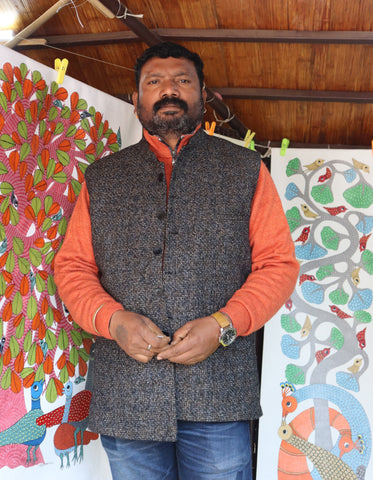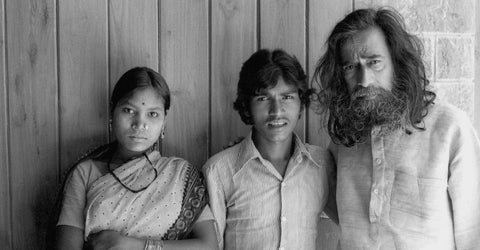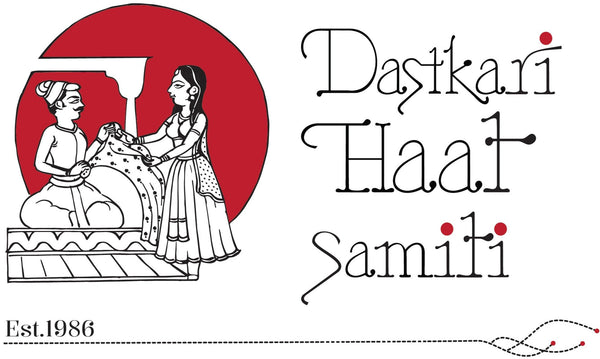If one closely observes nature, one might find how closely we are linked to it. The intricate parallels between human anatomy and the natural world are windows to stories often unseen and unheard. You’ll find them in the delicate ridges of fingerprints mirroring the growth rings within tree trunks and the luminous gleam in the eye akin to the radiant glow of sunlight. The branching veins coursing through the arm reminiscent of lightning streaks across the sky and the parched cracks in arid deserts echoing the textured patterns across human hands- all highlighting the shared rhythms and contours of existence.

Gond artist Dilip Shyam
Nestled in the lush green mountains of Madhya Pradesh, Gond, is one such Indian tribal community which reveres and reflects this interconnectedness between humans and nature. One might wonder how? Walk into a Gond village and the walls of every house would be painted with wondrous forms of flora and fauna. Hailing from village Pattangarh, artist Dilip Shyam narrates how Gond art embodies the essence of nature. “Every auspicious occasion or ceremony in Gond culture is marked with our tribal artwork done on the walls and floors of the house using natural colors- each obtained from different kinds of mitti (mud). Yellow color is made from ramraj soil, white color from chui and red color from geru soil. Originating from Amarkantak, the Narmada river provided our ancestors with mud of different types for crafting dhigna ( traditional geometric patterns) on the walls of the house. According to our folklore, the Narmada river, considered sacred, purifies sins and grants moksha through a simple bath or darshan. Artworks made of mud procured from Narmada ghat are considered to bring the household abundance and blessings.”
In the artistic tradition of the Gond tribe, we revere nature and its elements— the sun, the moon, and all that sustains us. While we believe in the existence of gods, their forms remain unseen. Thus, our art, dedicated to commemorating the divine, doesn’t take specific forms. Instead, it captures the essence of imagination in a simple yet profound manner, emphasizing expression over intricate details.
Usage of dots and fine lines prominently feature in Gond art. Enigmatic forms of wildlife can be seen rendered in Shyam’s paintings, tigers being one. The Bagh artwork pays homage to Baghbana Dev, revering the tiger as a deity. Within households, a dedicated corner is reserved solely for its worship, where a clay idol is crafted and venerated accordingly.

The King of the Wild, Acrylic on handmade paper
Aligning with it, he narrates an interesting tale, “There's this belief that during the wedding ceremony, the head of the family, known as the mukhya, becomes a vessel for Baghbana Dev, the tiger god. It's as if the spirit of the tiger enters him, blessing the union with its divine presence. As the groom's side presents themselves, they come bearing not only gifts but also a gesture of respect to the mukhya. For it is believed that without this offering, the ceremonial pheras cannot proceed.
The reason? Should Baghbana Dev feel slighted, the consequences could be dire. Without the customary gift, the mukhya's trance may turn tumultuous, for it may even try to bite the bride and groom.
And so, to prevent calamity, the groom's side always comes prepared, offering tokens of appeasement such as a pig, symbolizing respect and deference to Baghbana Dev. Only then, with the tiger spirit placated, can the sacred pheras be completed, and the union blessed with the divine harmony of man and nature.”
The worship of Baghbana dev, the tiger god offers insight into how cultural beliefs and rituals are intertwined with the natural world. The practice of bringing gifts, such as a pig, conveys the importance of maintaining harmony with the environment to ensure smooth social interactions. Cultural traditions reflect and reinforce people's relationship with the ecological systems they inhabit and Gond art aptly represents that.
Having practiced the art for thirty years, Dilip Shyam points out how every Gond artist has a signature style. Despite the theme being the same, different artists interpret and render it uniquely as per their diverse artistic expression. Shyam believes that Gond art today is where it is all because of his uncle and mentor, Shri Jangarh Singh Shyam. It was under his mentorship that each artist honed their individual artistic style. “The story of Gond art is incomplete without the mention of my Guru Shri Jangarh Singh. If it wasn’t for him, the world wouldn’t know about it.”

Jangarh Singh Shyam with wife Nankusia Shyam and mentor J. Swaminathan
Back in 1981 when he was busy grazing cattle, came artist J Swaminathan and his scouts looking for the talented individual whose art adorned the walls of Pattangarh. Hence began the journey of the stalwart of the revered tribal art, from a village to showcasing his flair for colors and form at Bharat Bhavan and overseas. A group of 25-30 Gond artists, including renowned figures like Bhajju Shyam and Durga Bai Vyam who collaborated with him, often gathered at his residence to work together. However, tragedy struck in 2001 when Jangarh Singh Ji passed away while working at the Mithila Museum in Japan. His untimely death left the Pardhan Gond community devastated, and without their leader, the group dispersed, each artist pursuing their own path.
“Chacha is no more with us, but his legacy lives on. Through his work and work ethics there's one thing that still stays with us: To always create one’s own unique style of artwork. Being individualistic and unique is the only way to excellence and recognition .”

